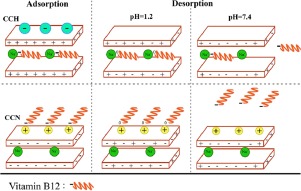Journal of the Taiwan Institute of Chemical Engineers ( IF 5.7 ) Pub Date : 2018-01-17 , DOI: 10.1016/j.jtice.2018.01.002 Zahra Ramazani Afarani , Mehdi Nasiri Sarvi , Mozhgan Akbari Alavijeh

|
In this study nanolayers of montmorillonite (MMT) were modified in order to develop a pH-responsive nanocarrier for delivery of vitamin B12. The vitamin B12 was adsorbed on the MMT nanolayers via cationic bridge mechanism by electrostatic attraction force. A facile treatment of MMT nanolayers was done by increasing the cation or anion concentration of the external surface of nanolayers. In all modified samples the interlayer spaces were filled with a cation (Na+). Such treatment mostly affected the place of adsorption of vitamin B12 which the MMT sample with the external surface of nanolayers enriched with anion (Cl−) tent to adsorb vitamin in the interlayer spaces due to the existence of cations just in the interlayer spaces. However, when the surfaces of nanolayers were enriched with the cation (Na+) vitamin B12 just adsorbed on the external surface of the nanolayers and almost no adsorption in the interlayer spaces was detected. The in vitro release results showed that almost no vitamin B12 was released from modified MMT nanolayers at low pH however by increasing the pH, vitamin started to release with steady kinetics. This could be due to the highly controlled mechanism of adsorption of the vitamin on the nanolayers (cation bridge) which was just desorbed when the highly acidic (highly saturated medium with H+) change to neutral condition (with increasing the possibility of exchangeable anions with the vitamin complex). In addition, the modification of MMT nanolayers affected the amount of vitamin released which when vitamin was intercalated in the interlayer space the release of vitamin became more difficult. The results showed that the modified MMT nanolayers preserved vitamin from the harsh condition of gastric before being released, making it a promising nanocarrier for drug delivery applications.
中文翻译:

改性蒙脱土纳米层作为生物分子的pH响应载体:维生素B12的传递
在这项研究中,对蒙脱土(MMT)的纳米层进行了改性,以便开发出一种pH响应型纳米载体,用于输送维生素B12。维生素B12通过静电引力通过阳离子桥机制吸附在MMT纳米层上。通过增加纳米层外表面的阳离子或阴离子浓度来完成MMT纳米层的简便处理。在所有改性样品中,层间空间都充满了阳离子(Na +)。这种治疗主要影响的维生素B12的吸附,其与纳米层的外表面上的MMT样品富含阴离子(CL的地方-)由于在层间空间中只存在阳离子,因此帐篷在层间空间中吸收了维生素。然而,当纳米层的表面富含阳离子(Na +)时,维生素B12仅吸附在纳米层的外表面上,并且几乎没有在层间空间中检测到吸附。在体外释放结果显示,但是通过提高pH值,几乎没有维生素B12从在低pH改性MMT纳米层释放,维生素开始稳步动力学释放。这可能是由于维生素在纳米层(阳离子桥)上的吸附机制受到严格控制的,而该机制只是在高酸性(H +高度饱和的介质)中才解吸的。)更改为中性状态(增加了与维生素复合物交换阴离子的可能性)。另外,MMT纳米层的改性影响了维生素的释放量,当维生素插入层间空间时,维生素的释放变得更加困难。结果表明,修饰的MMT纳米层在释放前能从恶劣的胃中保存维生素,使其成为有前景的用于药物输送的纳米载体。



























 京公网安备 11010802027423号
京公网安备 11010802027423号